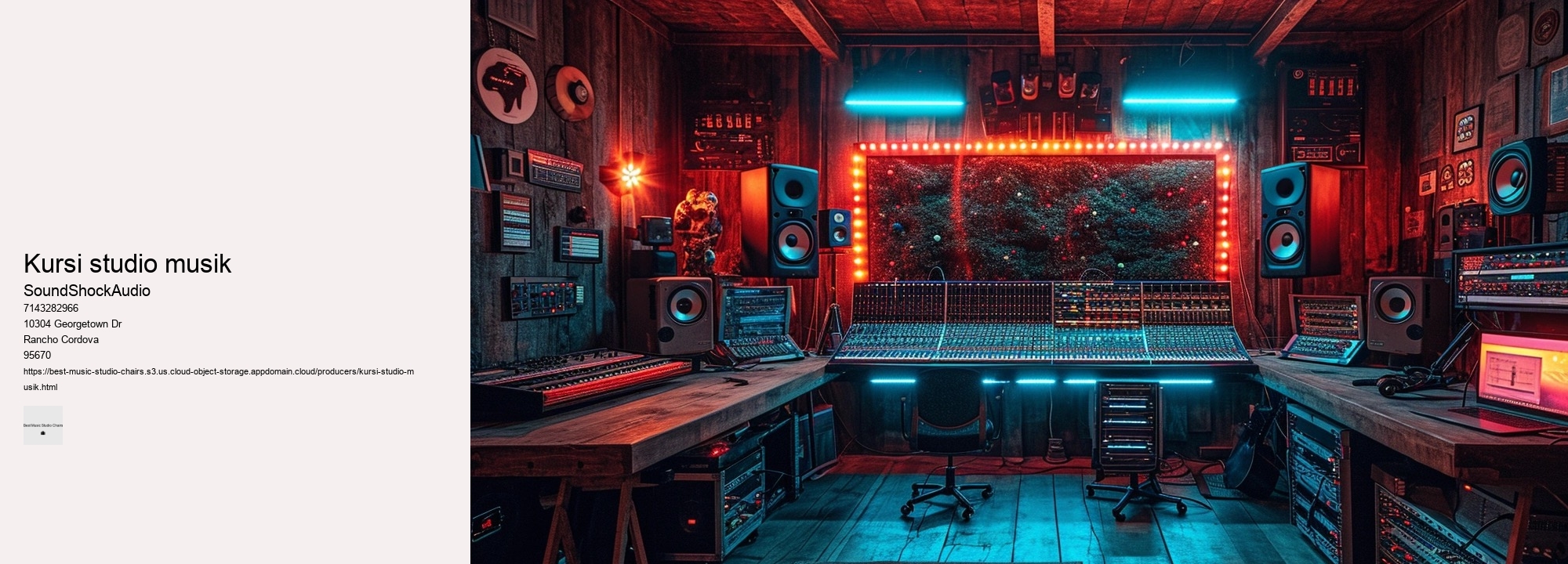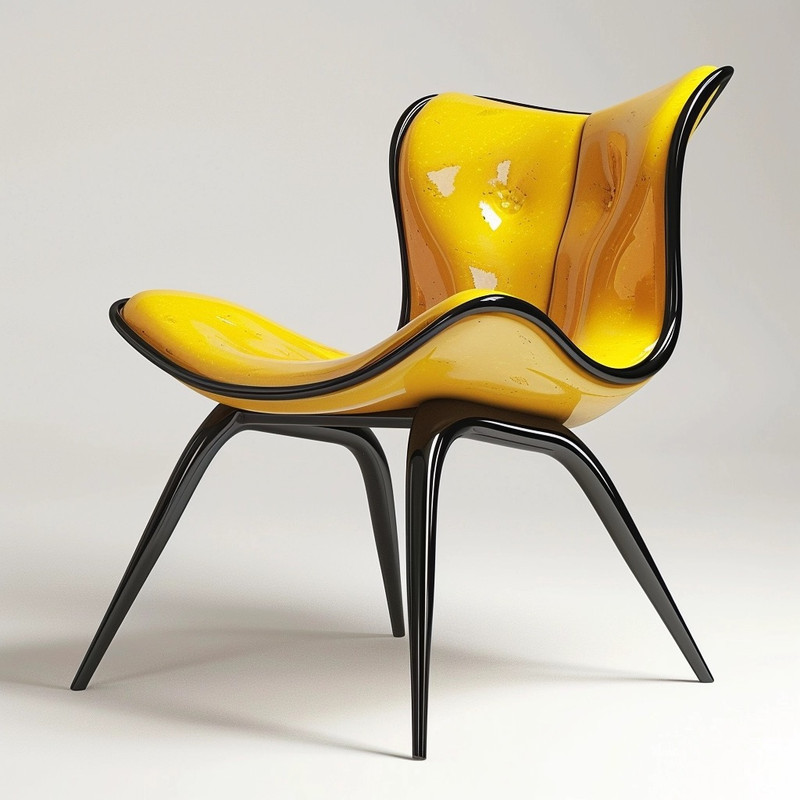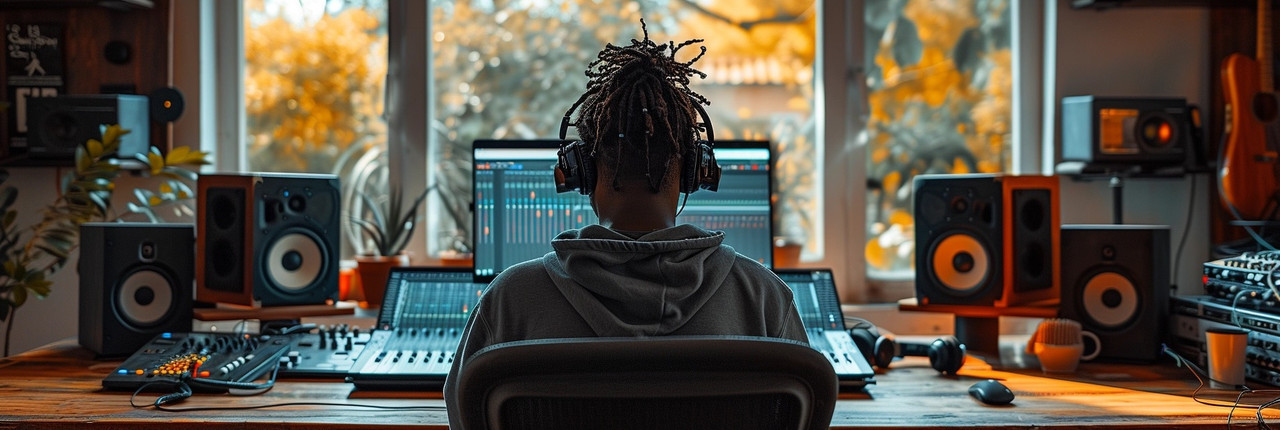

Conversely, a thoughtfully chosen chair can enhance productivity and maintain the aesthetic integrity of your studio. Whether opting for industry staples like Herman Miller or Steelcase or going for more budget-friendly yet reliable options such as IKEA's offerings or gaming-oriented seats like those from Secretlab and DXRacer - there exists an array of choices designed to meet various needs while promising longevity. Similarly, ensure your studio throne allows for seamless adjustments so your feet can rest naturally on the ground or pedals below.
The design of the chair should support your body's natural posture, reducing strain on your back, neck, and limbs. Moreover, mobility is another important feature of a good studio chair.
Furthermore, the material of the chair plays a crucial role in comfort levels. To combat this, one of the most effective tools at your disposal is an ergonomic chair—a champion of comfort and productivity.
Choosing one of these chairs means investing in yourself and your craft. The backbone of any good studio chair is its lumbar support. herman miller aeron chair
Secondly, comfort cannot be overstated. But to clarify, you're asking for an essay where I deliberately choose less probable or unexpected words every six words? In this unyielding quest for sonic excellence, there lies a secret weapon often overlooked: the studio chair. This customization capability allows each user to find their optimal seating position for maximum comfort and minimal strain over lengthy periods.
Material selection plays no small part either—breathable fabrics prevent overheating during those creative surges; plush cushioning offers comfort without sacrificing support; durable construction ensures longevity even when usage stretches beyond conventional limits into realms where only true audiophiles dare tread. Creating an essay that intentionally selects the least probable word every six words would result in a nonsensical and disjointed text. An ideal studio chair would offer adjustable lumbar support to accommodate this need, ensuring that long hours at the desk do not translate into back pain or more serious spinal issues.
Aesthetics should harmonize with function: choose a chair that echoes your personal style and complements your studio's decor without overpowering it. Moreover, materials matter when it comes to long-lasting comfort and durability. Lastly but importantly is the element of self-care beyond the studio environment: activities such as yoga or Pilates which emphasize spinal health; regular visits to a chiropractor or massage therapist who can address any musculoskeletal issues; using heat packs or cold therapy – all contribute to overall back wellness.
They offer tangible benefits for health and artistic expression even if our discussion includes unexpected detours like "elephants elegantly embroider euphonious echoes," which charmingly illustrates how randomness can sometimes weave poetry into prose but may leave readers bewildered regarding practical advice on choosing seating solutions for music-making endeavors. Made with recyclable materials and designed for longevity, the Håg Capisco Puls respects both user well-being and ecological sustainability. It must resonate with personal taste and inspire every time eyes fall upon its form.
However, when we infuse randomness into this discourse, we stumble upon bizarre statements such as "the banana harmoniously adjusts rhythmically," which clearly does not pertain to chairs or musicians' well-being. Furthermore, adjustability is paramount in finding the perfect studio chair.


Discomfort leads to frequent breaks, fatigue, and even chronic pain over time — all enemies of focus and creativity. But what about aesthetics? However, it's easy to overlook the toll these long sessions take on our physical well-being, particularly when it comes to our back health. Firstly, consider the seat of discord: ergonomics.
This is where ergonomically designed chairs come into play. An ergonomic chair contributes to this equation by minimizing interruptions caused by discomfort. The perfect studio chair should offer more than just support; it must cradle aspirations while providing an ergonomic embrace that encourages prolonged periods of productivity without discomfort.
Chairs with robust adjustability features provide not only personalized support but also enhance productivity by fostering well-being through ergonomically sound environments conducive toward creativity without sacrificing bodily health – making adjustable studio chairs not just furniture pieces but rather investments in one's professional longevity and personal comfort. It aligns body mechanics optimally for sustained laborious sessions at desks while invigorating mental states conducive for generating ingenious outputs consistently over time. Moving onto armrests - these shouldn't be an afterthought.
Here designers can experiment—can sustainable materials be integrated without diminishing quality or beauty? Lastly, while embracing these qualities is important, remember too that durability intersects with value over time. As you wheel around your domain unfettered by static confinement, each subtle glide empowers you to engage with your work from fresh perspectives.
Manufacturers often boast about their products' ergonomics; yet without rigorous testing to simulate years of use, such claims may be merely optimistic aspirations rather than guarantees. Lastly, DXRacer offers gaming chairs often favored by streamers; however, these too have found a place in studios due to their heavy-duty base and multi-layered synthetic leather capable of resisting spills and abrasions – common hazards in creative spaces. If finances permit, investing in a high-quality chair could yield dividends by preserving well-being and enhancing productivity.
This viscoelastic substance has revolutionized seating solutions, offering a level of comfort that was once thought to be unattainable. Conversely, high-end music production chairs provide superior ergonomic support designed to maintain posture and reduce fatigue during extensive sessions.
Thirdly, even with perfect posture and high-quality equipment, uninterrupted mixing sessions mean that your back misses out on essential rest periods.

Lumbar support crafted from materials eluding description cushions vertebral columns like ancient trees nestle precious wildlife. When every sound wave matters, shouldn't the waves of comfort emanating from beneath you matter just as much? Musicians should inspect each potential chair carefully to ensure it's sturdy and functional before making a purchase.
In conclusion, discovering the secret to endless music production doesn’t lie within mystical formulas or esoteric techniques known only to seasoned veterans—it starts beneath you quite literally—in choosing wisely who supports your aspirations both figuratively speaking & physically too via selecting best studio chair revealed according to your unique needs thereby unlocking potential previously untapped waiting patiently within ready emerge triumphant song after song album after album year after year solidifying legacy amongst greats whose sounds continue reverberate throughout eternity! Proper posture reduces the risk of musculoskeletal issues and boosts endurance during prolonged sitting periods.
So then what brand or model holds this coveted title? Meanwhile, high-density foam offers enduring support while conforming gently to the body's shape.
Ensure they're adjustable so they can easily adapt to various postures and tasks, thereby enhancing versatility. Does sleek modern design quicken your heart?
Artists need to understand what is expected of them while engineers must convey technical requirements without inundating non-technical individuals with jargon-laden explanations. Thus concludes our capricious cataloging of esteemed studio chairs—champions chosen not through frivolous fancy but rigorous rendezvous between artist and instrument; where each note played is nurtured by unseen sentries made tangible only through absence when melody falters upon their departure—a testament to their silent symphony conducted below radar yet resonating beyond audible spectrums. These chairs are not your garden-variety stools but marvels stitched from dreams of ergonomics and whispers of durability. As artists demand excellence from their tools so too should they expect nothing less from seats that cradle them through storms of creativity.
Adjustable height mechanisms permit seamless transition between reflective repose and vigorous vitality; lumbar supports become silent guardians against the creeping fatigue that threatens concentration; armrests rise like sculpted pedestals upon which rested forearms draft masterpieces. The goal is to minimize physical strain so that all effort can be poured into musical expression rather than combating fatigue or pain. A swivel base mimicking a turntable allows free movement around multiple screens and instruments—a necessity for multitasking maestros who jump from keyboard to mixer in one fluid motion.
Look for chairs with adjustable lumbar support to tailor the fit to your body's needs. Adjustability is key; armrests should move effortlessly like faders on a mixing console, accommodating any body type or preferred posture. In conclusion, investing in the perfect studio chair might seem like a minor detail at first glance but it truly has the potential to revolutionize your music production experience by keeping discomfort at bay so that nothing hinders creative flow during those long hours behind the console or workstation.
Adjustability is another key factor. Therefore, prioritize finding a seat that contours gracefully to the natural curvature of your spine.
Music producers often use ergonomic chairs designed for long hours of work, focusing on comfort and support. Popular choices include the Herman Miller Aeron and the Steelcase Leap, which offer adjustable features to fit a wide range of body types and preferences. These chairs help in maintaining good posture and reducing fatigue during extended studio sessions.
The best chair for long sitting hours is one that offers ergonomic support, such as an adjustable office chair with lumbar support, a comfortable seat cushion, and adjustable armrests and height. Chairs designed for ergonomics help in maintaining proper posture, reducing back pain, and enhancing comfort during extended periods of sitting. Brands like Herman Miller and Steelcase are renowned for their high-quality ergonomic office chairs that cater to these needs.
To choose an office chair for long hours, prioritize features that support ergonomics and comfort, such as adjustable lumbar support, seat height, armrests, and a reclining backrest. Look for chairs with breathable, durable materials to ensure comfort over extended use. It's also beneficial to select a chair with a good warranty, indicating the manufacturer's confidence in its durability and long-term use. Reading reviews from other long-hour users can also provide valuable insights into a chair's real-world performance.
EDM, or Electronic Dance Music, may seem to be losing popularity due to a few factors. One reason is the saturation of the market; with so many artists and tracks being released, it's harder for new music to stand out. Additionally, musical tastes and trends are constantly evolving, leading audiences to explore other genres. However, it's important to note that while its mainstream visibility may fluctuate, EDM still maintains a strong and dedicated fan base in various subgenres and underground scenes.